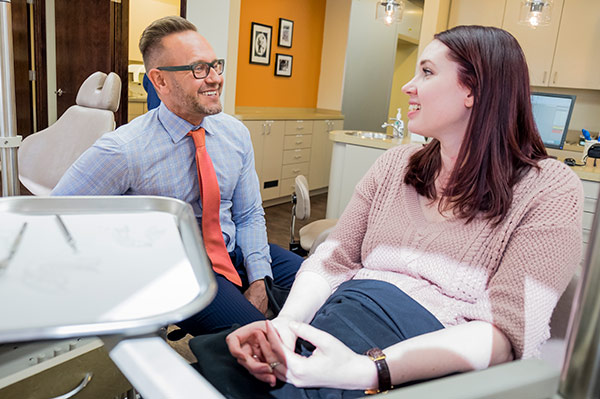It’s hard to appreciate how braces can help you if you don’t understand what’s wrong with your teeth! There are several common orthodontic problems that impact millions every year – even if your dentist explained them, you may not have fully understood what they meant.
If you’re wondering what the most common types of orthodontic problems are, read on and learn more about how they’re classified and what their names mean!
The Most Common Types of Orthodontic Problems
Crossbite
A crossbite malocclusion occurs when your upper jaw and your lower jaw’s alignment causes your upper teeth to sit “inside” your lower teeth when your mouth is closed. Essentially, some or all of the bottom teeth sit out of alignment with their comparative upper tooth.
Technically, crossbites are further classified by where they happen in the mouth. A more common case of crossbite is posterior, where it happens in the rear teeth. Anterior crossbite is less common and is when the alignment issue takes place in the front teeth.
Crossbites can cause issues with eating comfortably and with jaw development. They’re also one of the causes behind temporomandibular disorder (TMD) which can cause chronic pain in the jaw.
Underbite
When your upper teeth sit inside your lower jaw due to a misalignment of the teeth, that’s a crossbite. When they sit inside the lower jaw due to your lower jaw position being too far forward, it’s known as an underbite.
With an underbite, your teeth’s individual alignment may be healthy and straight, but the position of your jaw causes them not to properly connect and can push out your chin awkwardly.
The most common cause of underbites in children is when the lower jaw is growing at a quicker rate than the upper jaw. Orthodontic treatment can help prevent lifelong development problems due to underbite.
Overbite
Opposite an underbite, an overbite involves the upper jaw pushing the top teeth over the bottom teeth. In more extreme cases, overbites can actually allow the lower teeth to contact the roof of the mouth.
Overbites are problematic due to how they can impact your smile and the appearance of your lips – causing them to protrude out and show a lot of your gums when your smile. More importantly, your incisor teeth will experience more wear-and-tear with an overbite. Incisors are your sharp, front teeth, useful for cutting.
Open Bite
While many types of common orthodontic problems leave your teeth overlapping in uncomfortable ways, an open bite leaves some teeth not making contact at all. The most obvious problem with an open bite is chewing. When many of your teeth don’t contact each other, it’s hard to chew through thinner foods.
Your canines and incisors are towards the front of your mouth, where an open bite often happens. These teeth are critical for healthy eating.
One of the most likely causes of open bite is excessive thumb sucking. It’s one reason parents should try to curb thumb sucking early on in their child’s development. If ignored, it can cause open bites or other avoidable dental issues.
Crowding
One of the most common orthodontic problems leading to orthodontic treatment, crowding is when teeth overlap due to a lack of appropriate space for them to develop. Crowding will impact the look of your smile due a lack of symmetry and uniformity among your teeth.
Functionally, crowded teeth become difficult to care for. As teeth overlap at awkward angles or with little space between them, brushing and flossing becomes less effective. Untreated crowding increases your chances of developing severe decay.
Spacing
On the other hand, teeth can also erupt too far apart. While this is often due to a missing tooth, spacing can happen if your jaws develop larger than the erupting teeth can fully fill.
Unlike crowding, spacing won’t necessarily increase your risk of developing decay. However, the increased gaps between your teeth can be aesthetically displeasing. Likewise, eating can be uncomfortable with foods that are capable of getting stuck between the gaps of your teeth.
Overjet
Your top front teeth normally sit slightly in front of the lower front teeth. When your teeth have an overjet, they stick out further from your bottom teeth than normal. This is often referred to as “buck teeth.”
Unlike overbites, overjets aren’t the result of your upper jaw positioned past your lower. It’s actually a horizontal alignment issue, where the teeth angle away from resting comfortably above the lower teeth.
An overjet is more of a cosmetic issue than a health one, though it can make your teeth more vulnerable to damage!
What Options Are There for Treatment?
These common orthodontic problems are all generally treatable with an orthodontic appliance. There are several types of braces available nowadays, each with their own unique looks and benefits. Depending on the severity of your orthodontic diagnosis, you may be able to go through treatment with whichever type you prefer.
In rarer cases, orthodontic problems are severe enough to require orthodontic surgery. If this is the case, your orthodontist will explain your options and what they entail.

Schedule a Free Consultation
Do you have questions about how to best take care of your braces? We can answer your questions to keep your teeth and gums healthy – schedule a free consultation! Contact us online or call 440-842-8015
Stay connected with Doctor Andy on Social Media!




